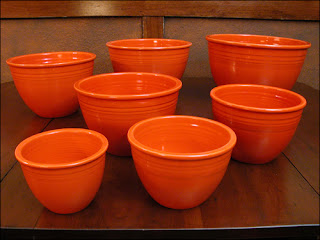 |
| Red Fiesta Mixing Bowls |
Red Fiestaware was produced from 1936 until 1943. Because the red glaze contained uranium oxide, the US Goverment confiscated Homer Laughlin's supply during WWII for use in the atomic bomb project. Red Fiestaware didn't return until 1959.
Fiestaware's designer, Fredrick Rhead, also designed the Harlequin and Riviera pottery lines.
In 1986, Homer Laughlin returned Fiestaware to the market. These new pieces are slightly stronger than the vintage pieces due to an updated clay formula.
 |
| Harlequin |
It can be hard to tell some vintage and modern pieces apart. Here are some tips:
- Fiestaware with an ink stamp of “FIESTA” in all uppercase is always post-1986. Fiestaware with an ink stamp of “fiesta” in all lowercase is always vintage. (This is only true for ink stamps and not the indented marks.)
- The pieces with indented backstamps can be trickier. Anytime you see a capital "H" it is ALWAYS post-86. However, the absence of an "H" does not guarantee that is is vintage.
- Anytime you see "lead free" on the bottom it is always a post-86 piece.
- ook at the bottom of a piece, vintage Fiestaware often has three tiny marks on the bottom from the firing process. New Fiestaware does not.
- Any pieces with numbers or letters stamped on the bottom are vintage. These stamps were used for quality control purposes and are not present on any post-86 pieces.
 |
| Post-1986 |
 |
| Pre-1986 |
For the chronology of colors visit http://www.hlchina.com/fiestacolors.htm.
For a complete Fiestaware price guide visit www.happyheidi.com/antiques/Fiesta-Price-Guide.html

I have heard not to refer to this china as Fiestaware (one word) it is Fiesta. If you must add "ware" to it, it is a separate word.
ReplyDeleteWho cares what poeple call it, it's pretty.
ReplyDelete